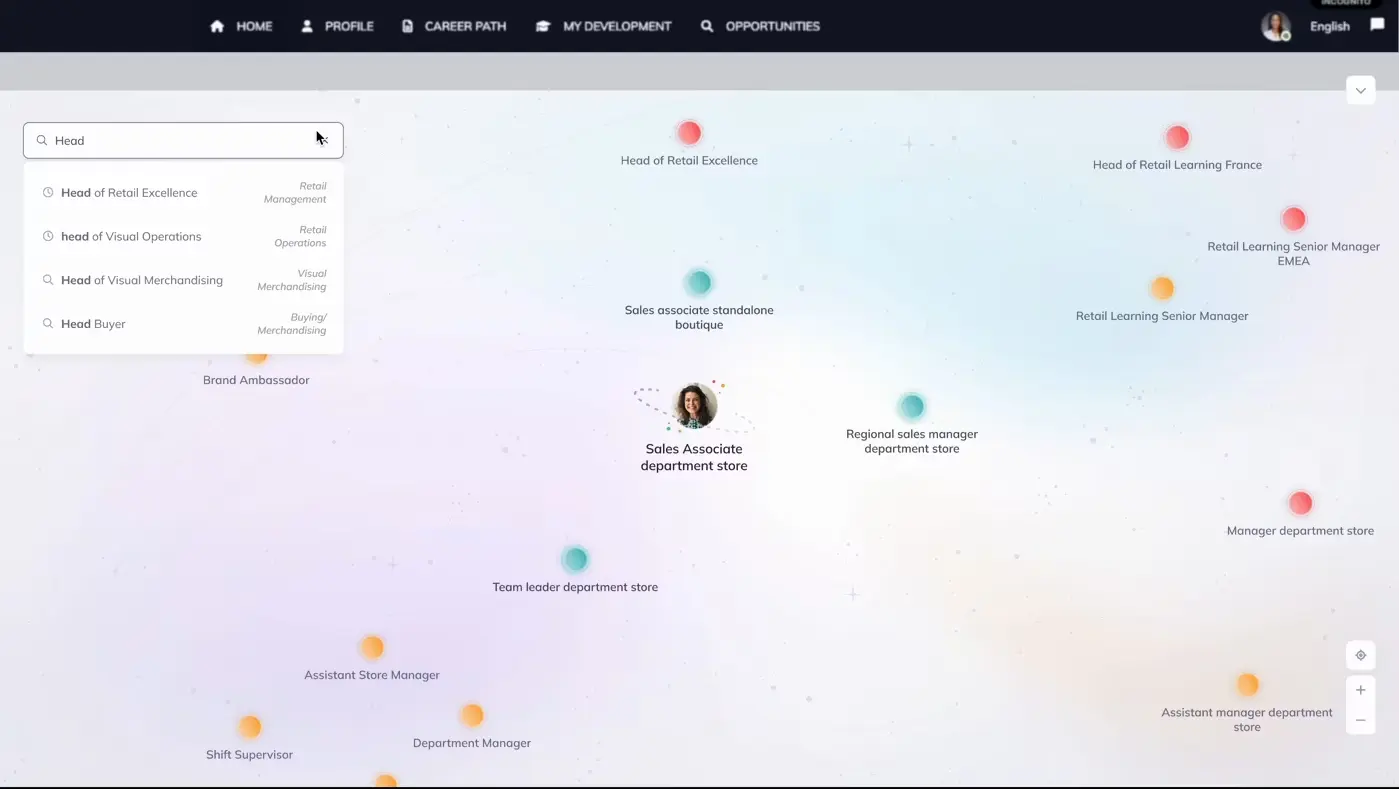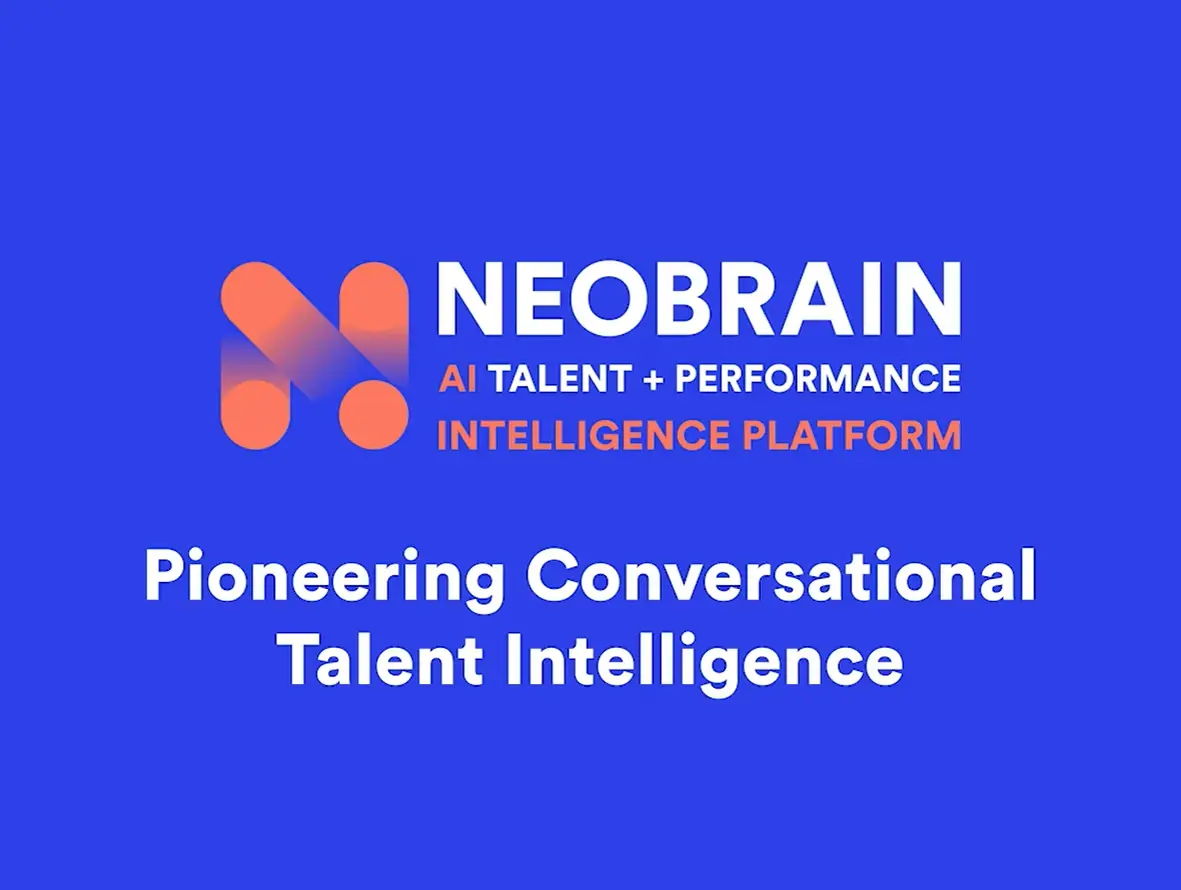Artificial Intelligence for Human Resources
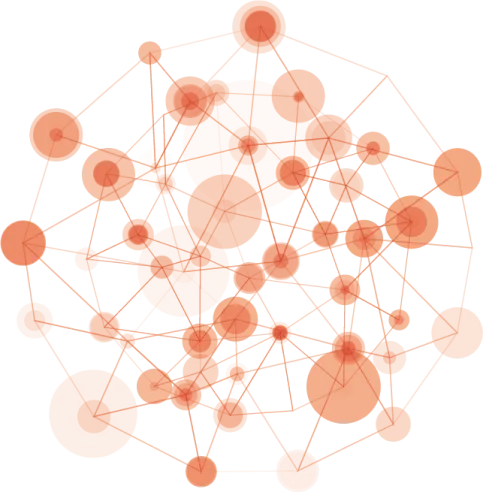
Understanding artificial intelligence in the HR context
What are the different AI modalities for Human Resources?
Machine learning
At the heart of AI, machine learning is a sub-discipline in which systems improve their performance autonomously, building on acquired experience without being explicitly programmed for each task.
Natural language processing (NLP)
A particularly relevant application of machine learning in the field of human resources is natural language processing (NLP), which facilitates interaction between computers and human language, making it possible to analyze and understand written or verbal communications in the workplace.
Large Language Models
Broad Language Models (LLMs), thanks to their ability to predict the next text from huge volumes of previously analyzed text data , open up new perspectives for automatic content creation and administrative task assistance. Chat GPT is an LLM. This pre-trained generative language model (GPT), designed by OpenAI, has been fed with vast textual corpora. It is capable of generating complex textual responses on demand, providing invaluable support in the drafting of job descriptions or annual appraisal reports, for example.
These technologies illustrate the diversity and richness of AI applications in the human resources sector, transforming traditional methods of talent management, recruitment, and professional development.
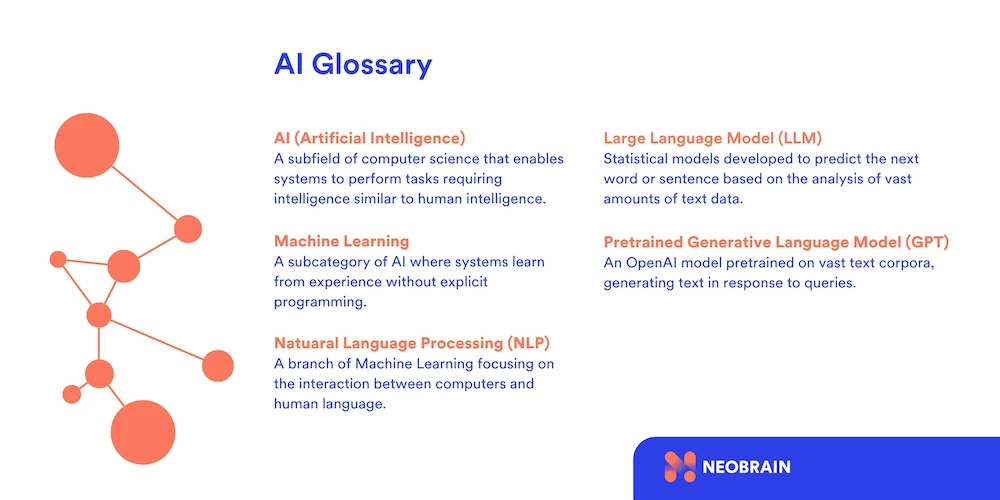
Which HR activities can really benefit from artificial intelligence?
The HR activities that can benefit from AI are based on different modalities. We can distinguish several families of activities: behavioral analysis, event prediction, adaptation of the service offering, or the creation of training documents or materials.
Analyze behavior
Whether it’s retention or opinions on HR policy, techniques are evolving from neural networks to natural language processing.
Predicting events
It is possible to predict that an individual will leave the company or that a psychosocial risk will occur. To do this, neural networks will be used.
Tailor services
Personalizing career and training offers becomes a reality through the use of Large Language Models.
Creating job descriptions
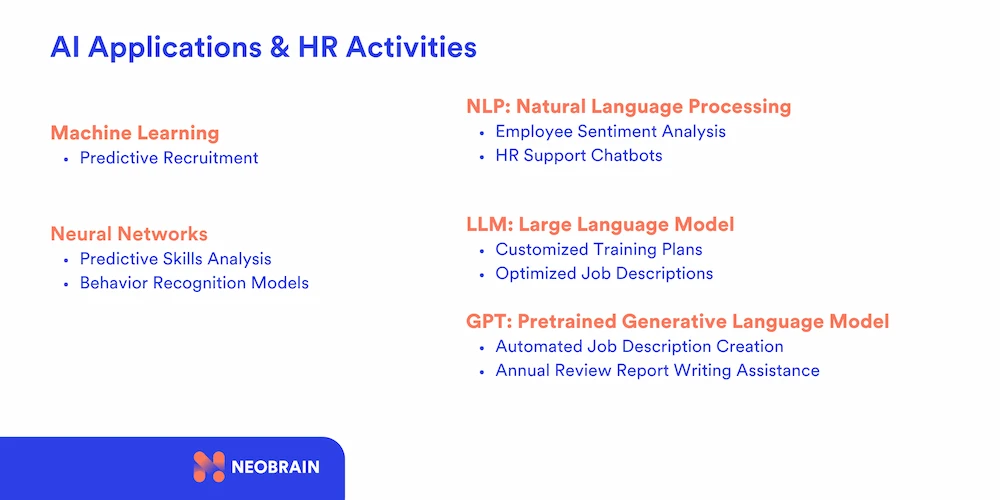
The benefits of AI for all HR players
The quality of the user experience is central to the adoption of an HRIS. Neobrain’s AI facilitates the use of your HR software in the daily life of each HR actor:
- Employees: Personalization of career paths, suggestions for internal opportunities and training.
- Managers: Individualize relations with your employees and their preferences, thanks toActive Learning*.
- Human Resources: Automatic generation of nomenclatures, centralization of indicators for better decisions.
The benefits of AI for employees
What do employees want from their software space? Two things come first: easy access to information and suggestions to guide them in their careers.
A better employee experience thanks to AI
Customized career streams suggestions
Thanks to the personalization offered by AI, 88% of our users visit the Neobrain platform 3 times a month.
The HR and AI pairing brings new perspectives to the desire to know and support employees in their trajectories. Data Science and Machine Learning are at the service of large-scale data analysis within the company. In a context of accelerated HR transformation, AI’s real-time suggestions and recommendations form a decision-making tool in the hands of all HR players.
AI use cases for the HR function
What do employees want from their software space? Two things come first: easy access to information and suggestions to guide them in their careers.
Uniting talents, aspirations and opportunities
Formatted professional developments have reached their limits. Combine skills and appetite feeds the creation of varied and more engaging career paths. Our matching engine skills has several benefits that are quickly visible:
- Aligning talent with organizational needs;
- The best allocation of resources with projects;
- Talent retention through consideration of their appetites;
- Employee mobility and development.
Practical support for decision-makers
HR teams constantly get questions from their managers, but can they always answer them? When it comes to issues requiring the use of quantitative data, simpler solutions are needed. That’s why Neobrain has partnered with Microsoft to offer the best in HR software platform navigation. Video illustration:
Focus on “artificial intelligence and management skills”
AI use cases for the HR function
The current situation regarding the skills shortage is crystal clear:
- 80% of companies have difficulty finding the resources they need(Manpower 2023 study).
- 60% of employees feel that their company does not capitalize on all their available skills(WEF).
Consequently, one of the ways of improving resource allocation is to identify skills that are still unknown, as they are not listed in the rigid nomenclatures of corporate professions. AI makes it possible to bring out these hidden skills and talents, and give them the chance to express themselves to the full.
Our semantic analysis engine detects, structures and valorizes every skill of the organization. Don’t limit yourself to self-declaration of employee skills. Use our multilingual semantic analyzer to capture the full richness of their skills implicit skills, and bring to light unknown qualifiers that the company can draw on for its business.
Accelerate the creation of permanent repositories
Structure your skills management platform seamlessly, thanks to 2 Neobrain advantages:
- Ourautomatic repository generation engine .
- Ourtool for checking the consistency of created repositories.
Thanks to the hybrid model devised by our Customer Projects team, repository creation times are cut by a factor of 4 on average.
AI in support of a proven skills ontology:
72 000 skills and 26,000 jobs are analysed daily through natural language processing. This methodology for exploiting and formalizing your HR data divides by 4 the time it takes to complete the business repositories and skills.
Our semantic analysis engine understands your specific sectors and businesses, and provides you with a benchmark of skills emerging from your competitive environment.
Focus on “artificial intelligence and management skills”
How can we identify the impacts of AI on Businesses and skills?
To identify the impact of AI, we don’t need to look directly at our businesses, but first examine our day-to-day tasks. Ernst & Young examined this technological advance and the expectations of managers in a 2023 study. What emerges is a strong expectation of increased operational efficiency on the part of business leaders.
The 8 criteria for assessing the potential impact of AI on our jobs:
- Is it a task with a physical dimension?
- What level of human interaction is required to accomplish this task?
- What degree of professional expertise is required?
- Does this task involve handling a lot of data?
- What are the regulatory constraints on its execution?
- What are the risk factors involved?
- What are the requirements in terms of creativity and strategy?
- How complex do we consider this task to be?
Neobrain has put together an application based on several studies, the methodology of which we detail here. You can access the analysis of 100 professions.

The profession is already adopting Generative AI and is becoming aware of its interest in the productivity of its teams and the impact on the various businesses. The urgency of assessing business changes, potential task automation and productivity gains are among the concerns that Neobrain addresses with precision.
An illustration of the Administrative and Financial Management professions
Neobrain and its partner PWC have carried out an extensive investigation into the integration of traditional AI and generative AI in finance departments. Among the insights provided on how executives see the spread of these technologies in the CFO, nearly 80% have not yet spread the word. However, 66% believe it will lead to the need to acquire new skills. We have modeled the impacts and synergies of these 2 technologies on the main activities of this department.
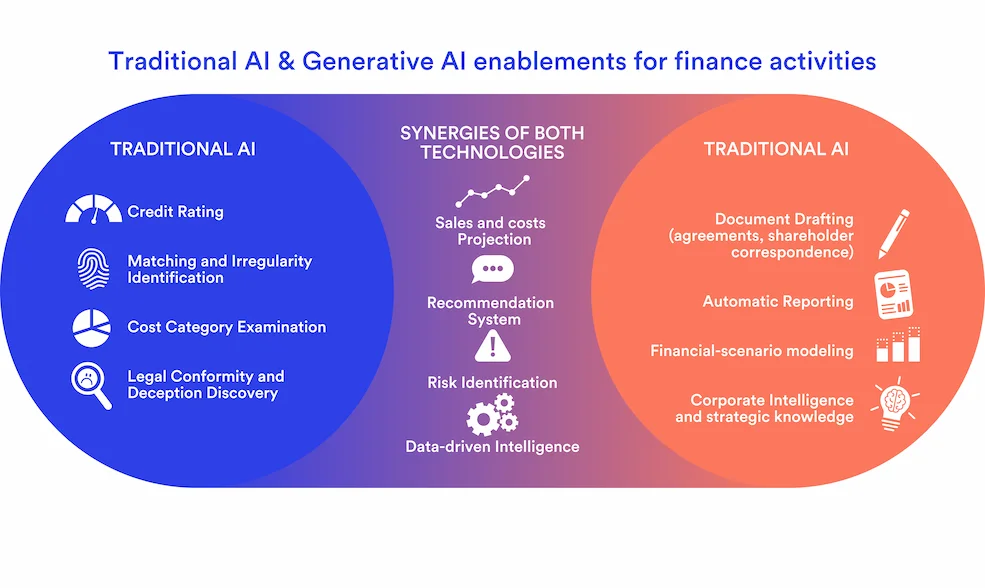
Limits and future challenges of AI in the organization
An illustration of the Administrative and Financial Management professions
While the use of AI by employees is increasingly common, it is not always reflected in overall corporate strategies. Indeed, McKinsey cites a figure of 22% of employees using the tool on a daily basis, with usage in the order of 33% in the technology, media and telecoms sectors. Despite the importance attached to AI, which is among the top five priorities of large companies, just over 10% have actually assessed its impact on their business .
Startingthe thinking process involves obstacles, which is why Neobrain offers a method and key success factors available in our roadmap.
How do you stand up to the competition? Are you lagging behind or in step with current trends? How are other companies using these technologies to improve productivity?
We dissociate 3 types of AI usage:
1. AI for personal use, such as intelligent personal assistants, optimizes daily tasks and time management, and is highly appreciated in technology sectors and at jobs , where efficient time management is essential.However, cost and variability in the quality of tools can be a hindrance, particularly for SMEs.
2. Second Use: Business process optimization.automated management systems used in logistics, RPA and CRM are transforming and improving the efficiency of internal operations, with high adoption in large companies in the manufacturing, retail and financial sectors. The main obstacles include high initial costs and systemic integration challenges.
3. Third use: Technological delivery to end customers. Integrating AI into products and services offers advanced functionalities such as personalized recommendations, particularly in consumer-oriented sectors such as retail and telecommunications. The challenges lie in the need for deep understanding of customer data and advanced analytical capabilities.
Find out more to assess your current level of maturity with our article “The real adoption of AI in business“.
Ethics and AI
The integration of artificial intelligence into HR processes raises major ethical challenges, mainly linked to AI biases. These biases can cause unintentional discrimination, affecting diversity and equity within organizations. Recognizing the existence of these biases, whether they stem from training data or algorithm design, is crucial to effectively mitigating them. The Gender Shades project is a striking example of this, having highlighted significant inequalities in facial recognition technologies according to gender and skin color.
The presence of bias in AI can lead to discrimination in critical areas such as recruitment and performance appraisal, where biased algorithms favor certain groups over others. Cases such as Amazon’s automated recruitment system in 2014 demonstrate the risks of discrimination, particularly gender discrimination, when a system is trained on unrepresentative historical data.
To counter these risks, companies need to adopt responsible AI practices. This includes:
- The use of diversified and representative data
- Collaboration with multidisciplinary teams when designing algorithms and regular audits of AI systems.
Digital Sovereignty
The issue of data sovereignty takes on a critical dimension in the context of AI use, particularly with publicly accessible tools such as ChatGPT. Companies need to be aware of the risks associated with using external AI services, including the loss of control over sensitive data, which may be governed by foreign legislation or exposed to third parties. This raises compliance and security issues, as well as intellectual property concerns. Companies such as Veolia and Axa have adopted Secure GPT, based on Microsoft’s Azure OpenAI service.
Data anonymization appears to be an indispensable step when using AI tools to process sensitive information. However, to maximize the benefits of AI while preserving data security and confidentiality, companies will rightly be stepping up their requirements.
In conclusion, our experience teaches us that it is vital to identify specific use cases before embarking on the distribution of AI-intensive software. Here are the use cases for which the Neobrain team has already demonstrated its value:
Proactive identification of departure risks:
By analyzing various indicators such as employee engagement, satisfaction and performance, artificial intelligence can detect early warning signs of a potential departure, enabling HR departments to act upstream to retain talent.
Reliability of succession plans:
AI analyzes the success and failure histories of past successions to establish correlations between different variables. This provides a numerical estimate of the probability of success or failure of future succession plans, improving their reliability and efficiency.
Anticipating future needs skills:
Through predictive analysis of current skills and market trends, artificial intelligence helps to forecast the skills required in the future, enabling recruitment strategies and training programs to be adapted to meet future needs.
Creation of skills frameworks:
Artificial intelligence helps to rapidly build skills architectures based on external observatories, job board data and semantic analysis of existing client company repositories.




